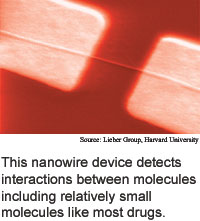
Nanowires track molecular activity
As molecules go, DNA and viruses are relatively
large. Many prototype sensors are aimed at detecting large biological
molecules, but small organic molecules also play important roles in biological
systems, and most pharmaceutical drugs are small molecules.
Researchers from Harvard University have found a way to use transistors
made from silicon nanowires to gain information about how small molecules
bind to proteins. The nanowires are 20 nanometers in diameter, and the
electrical conductance of the devices changes measurably depending on
whether target molecules bind to receptor molecules attached to the nanowires.
A nanometer is one millionth of a millimeter, or the span of 10 hydrogen
atoms.
The nanowire transistors could eventually be used in sensor arrays
capable of simultaneously detecting many different molecules, including
small organic molecules. The method is potentially capable of rapidly
screening drug candidates, according to the researchers.
The researchers' prototype consists of arrays of several dozen
sensors that sense when adenosine triphosphate (ATP) molecules bind to
the receptor molecules on the nanowires. The researchers showed that the
device could measure how effectively the small molecule drug Gleevec blocked
the ATP-receptor binding.
The receptor molecule Abl binding with ATP is part of a cell signaling
process that, when altered, plays a role in many diseases. Gleevec is
used to treat chronic myelogenous leukemia.
The researchers also showed that it is possible to measure the
degree to which four other small molecules blocked the ATP binding.
The sensors could be ready for practical use in two to five years,
according to the researchers.
The work appeared in the February 14, 2005 issue of the Proceedings
of the National Academy Of Sciences.
Stories:
Tool turns English to code
Common sense boosts speech software
Inkjet prints human cells
How it Works: Biochips
Briefs:
Nanowires track molecular activity
Microdroplet makes mighty microscope
Cheap material makes speedy memory
Tiny crystals adjust laser colors
Electricity controls biomolecules
Nanotubes juice super batteries
Layers promise cheap circuits

Research Watch blog
View from the High Ground Q&A
How It Works
RSS Feeds:
News
Ad links:
Buy an ad link
Ad links: Clear History
Buy an ad link
|
TRN
Newswire and Headline Feeds for Web sites
|
© Copyright Technology Research News, LLC 2000-2010. All rights reserved.